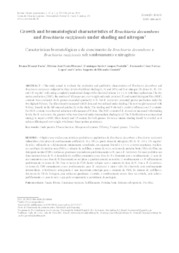Growth and bromatological characteristics of Brachiaria decumbens and Brachiaria ruziziensis under shading and nitrogen.
Growth and bromatological characteristics of Brachiaria decumbens and Brachiaria ruziziensis under shading and nitrogen.
Author(s): FARIA, B. M.; MORENZ, M. J. F.; PACIULLO, D. S. C.; LOPES, F. C. F.; GOMIDE, C. A. de M.
Summary: ABSTRACT This study aimed to evaluate the productive and qualitative characteristics of Brachiaria decumbens and Brachiaria ruziziensis subjected to three levels of artificial shading (0, 36 and 54%) and four nitrogen (N) doses (0; 50; 100 and 150 mg dm-3 soil), using completely randomized design with a factorial scheme 2 x 3 x 4, with three replications. The dry matter production (DMP), the number of tillers per pot, root weight and crude protein (CP) and neutral detergent fiber (NDF) contents were evaluated. Both grasses responded quadractly to N, but B. ruziziensis presented greater production under the two highest N doses. The tillers density increased with N dose and was reduced under shading. The root weight increased with N dose, linearly in the full sun and quadractly in the shade. The shading and N showed a positive influence on CP contents. For NDF content, was observed reduction with increase of N dose. The NDF content of B. decumbens increased with shading levels; for B. ruziziensis, the greatest value was observed under intermediate shading level. The N fertilization is an important strategy to improve DMP, tillers density and CP content, for both grasses. However, intense shading should be avoided, as it reduces tillering and root weight, which may threat pasture persistence.
Publication year: 2018
Types of publication: Journal article
Unit: Embrapa Dairy Cattle
Observation
Some of Embrapa's publications are published as ePub files. To read them, use or download one of the following free software options to your computer or mobile device. Android: Google Play Books; IOS: iBooks; Windows and Linux: Calibre.
Access other publications
Access the Agricultural Research Database (BDPA) to consult Embrapa's full library collection and records.
Visit Embrapa Bookstore to purchase books and other publications sold by Embrapa.

